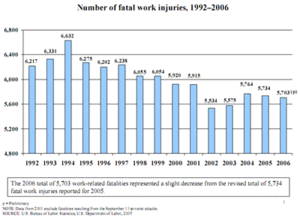
According to Steven Bell, senior associate with law firm
Freehills, in January 2012 the new Australian OHS laws will expect companies to drive safety management internally and push greater alignment between key messages and action.
The new laws will introduce a level of personal responsibility that will help drive the changes needed for better OHS. This means that senior managers will be expected to foster a positive workplace culture, receive regular safety reporting and a practical understanding of what is happening on the ground.
This is a great step forward as senior management actually drive the safety culture of a company.
Currently, most companies promote a safety culture, but send out mixed messages when it comes to a safe workplace. For example: A fairly standard grumble by many workers is that they are expected to work safely, yet at the same time they are told to work faster or in a way that involves safety risks, to drive productivity.
So with the new requirement to promote safety messages and show evidence of a positive safety culture, what is the best way to communicate workplace safety messages?
With any
communication program, it is important to take into account that people absorb messages differently and the more they see it, the more likely it will be taken on-board. Therefore, any workplace safety communication messages need to include a variety of communication approaches such as posters, training videos, staff newsletter and 'toolbox' talks. They all need to be branded with the company's unique safety messages.
In addition, the workplace safety communication must be personalised to the company. Generic safety messages won't cut it. Instead, it needs to be formulated according to your culture and demographics. And then it needs to be followed up with action.
Training videos are more persuasive than written material which is perceived as less important and credible.
A lot of companies that we have worked with have successfully used a
customised training video as the main communication medium to drive OHS behaviour change. They have then supported the training video with posters, newsletters and other safety specific materials.
A
staff training video is an ideal way to connect with staff. Made correctly it will positively and believably demonstrate your company commitment to the healthy and safety of your workplace. After all, research has found that training videos are more persuasive than written material which is perceived as less important and credible.
In order to take into account the new laws, consider creating a customised training video that includes:
- An introduction by senior managers talking about the importance of safety to the staff and company.
- Safety rules/explaining that poor safety effects the viewer and other workers
- Procedures
- Summary
Of course, just playing a
training video doesn't automatically ensure that staff will know your training messages. It needs to be followed up with a consistent workplace culture that always considers the safety rules/message in every activity. Not just when played on a training video.
More importantly, senior management must support and agree with all the safety communication tools. And refer to them often.
After all, staff won't believe that the company backs its safety messages, until they see the proof of action.


 According to Steven Bell, senior associate with law firm Freehills, in January 2012 the new Australian OHS laws will expect companies to drive safety management internally and push greater alignment between key messages and action.
According to Steven Bell, senior associate with law firm Freehills, in January 2012 the new Australian OHS laws will expect companies to drive safety management internally and push greater alignment between key messages and action.

